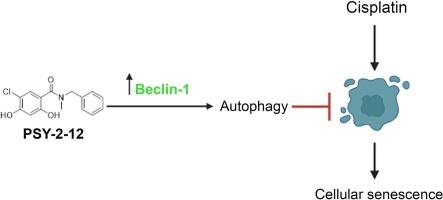hsp90特异性抑制剂psy2 -12通过激活自噬改善细胞衰老:急性肾损伤的潜在衰老治疗靶点
IF 5.6
2区 医学
Q1 PHARMACOLOGY & PHARMACY
引用次数: 0
摘要
热休克蛋白90 (HSP90)抑制剂-长期以来作为癌症治疗药物-最近被发现具有意想不到的老年治疗功能。在这项研究中,我们使用了一种hsp90特异性抑制剂PSY-2-12 (PSY)来探索其作为一种同源性药物的潜在治疗应用。我们证明,在无毒浓度下,PSY可以减少顺铂(CP)诱导的衰老肾近端小管细胞和血管紧张素ii诱导的衰老人脐静脉内皮细胞的细胞衰老。在cp诱导的急性肾损伤(AKI)小鼠模型中进一步证实了PSY的抗衰老作用。与对照组相比,PSY治疗减轻了cp诱导的肾损伤,如尿素、肌酐和肾损伤分子-1水平的降低,并改善了cp诱导的衰老,如β-半乳糖苷酶染色和p16表达的降低,以及层粘连蛋白B1水平的增加。在机制上,我们发现PSY通过beclin-1介导的自噬刺激发挥其老年治疗作用。PSY增强了cp处理的近端小管细胞beclin-1的表达和自噬通量,而自噬的抑制逆转了PSY的治疗作用。同样,beclin-1基因的敲除也消除了保护作用。综上所述,我们的研究结果表明,hsp90特异性抑制剂PSY可能作为治疗AKI的一种有前景的同源性治疗剂。本文章由计算机程序翻译,如有差异,请以英文原文为准。

HSP90-specific inhibitor, PSY-2–12, ameliorates cellular senescence via activating autophagy: A potential senotherapeutic target against acute kidney injury
An unexpected senotherapeutic function of heat shock protein 90 (HSP90) inhibitors—drugs long developed as cancer therapeutics—has recently been revealed. In this study, we employed an HSP90-specific inhibitor, PSY-2–12 (PSY), to explore its potential therapeutic application as a senomorphic agent. We demonstrated that PSY, at non-toxic concentrations, reduces cellular senescence in both cisplatin (CP)-induced senescent kidney proximal tubular cells and angiotensin II-induced senescent human umbilical vein endothelial cells. The anti-senescent effect of PSY was further confirmed in a mouse model of CP-induced acute kidney injury (AKI). PSY treatment attenuated CP-induced kidney injury, as evidenced by decreased levels of urea, creatinine, and kidney injury molecule-1, and ameliorated CP-induced senescence, as shown by reduced β-galactosidase staining and p16 expression, along with increased lamin B1 levels compared with controls. Mechanistically, we found that PSY exerts its senotherapeutic effects through beclin-1–mediated stimulation of autophagy. PSY enhanced beclin-1 expression and autophagic flux in CP-treated proximal tubular cells, while inhibition of autophagy reversed the senotherapeutic effects of PSY. Similarly, beclin-1 knockdown abolished the protective effects. In summary, our results suggest that PSY, an HSP90-specific inhibitor, may serve as a promising senomorphic therapeutic agent for the treatment of AKI.
求助全文
通过发布文献求助,成功后即可免费获取论文全文。
去求助
来源期刊

Biochemical pharmacology
医学-药学
CiteScore
10.30
自引率
1.70%
发文量
420
审稿时长
17 days
期刊介绍:
Biochemical Pharmacology publishes original research findings, Commentaries and review articles related to the elucidation of cellular and tissue function(s) at the biochemical and molecular levels, the modification of cellular phenotype(s) by genetic, transcriptional/translational or drug/compound-induced modifications, as well as the pharmacodynamics and pharmacokinetics of xenobiotics and drugs, the latter including both small molecules and biologics.
The journal''s target audience includes scientists engaged in the identification and study of the mechanisms of action of xenobiotics, biologics and drugs and in the drug discovery and development process.
All areas of cellular biology and cellular, tissue/organ and whole animal pharmacology fall within the scope of the journal. Drug classes covered include anti-infectives, anti-inflammatory agents, chemotherapeutics, cardiovascular, endocrinological, immunological, metabolic, neurological and psychiatric drugs, as well as research on drug metabolism and kinetics. While medicinal chemistry is a topic of complimentary interest, manuscripts in this area must contain sufficient biological data to characterize pharmacologically the compounds reported. Submissions describing work focused predominately on chemical synthesis and molecular modeling will not be considered for review.
While particular emphasis is placed on reporting the results of molecular and biochemical studies, research involving the use of tissue and animal models of human pathophysiology and toxicology is of interest to the extent that it helps define drug mechanisms of action, safety and efficacy.
 求助内容:
求助内容: 应助结果提醒方式:
应助结果提醒方式:


